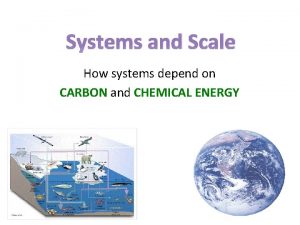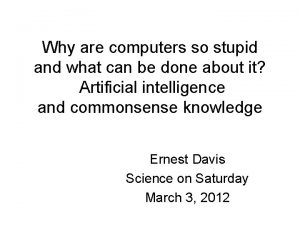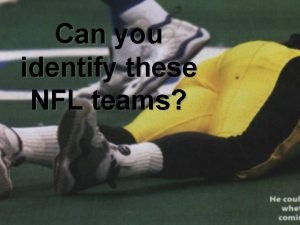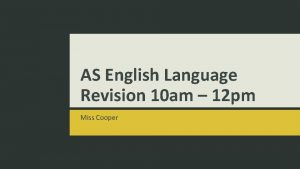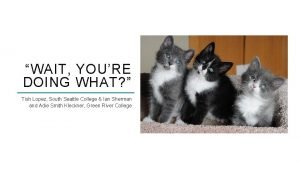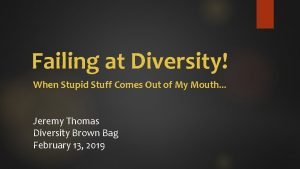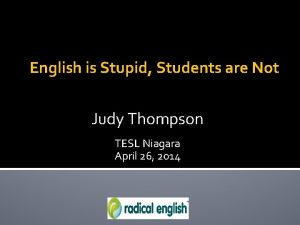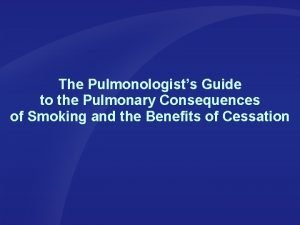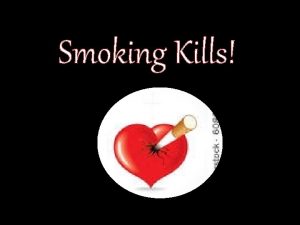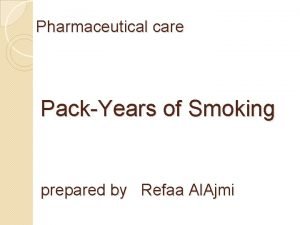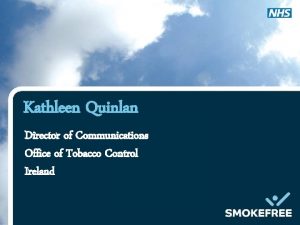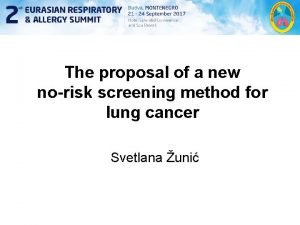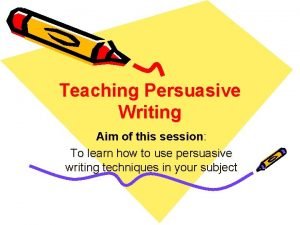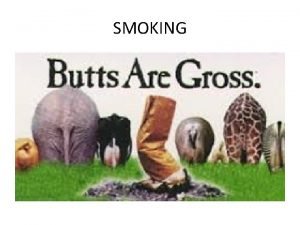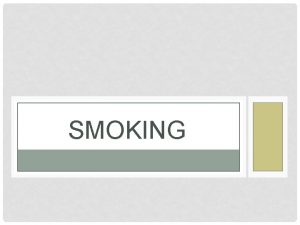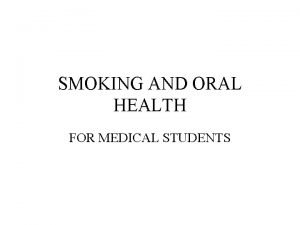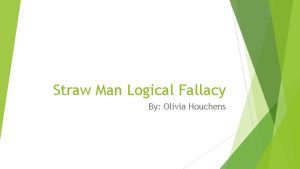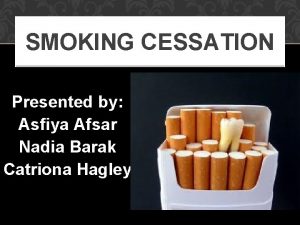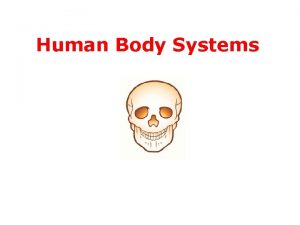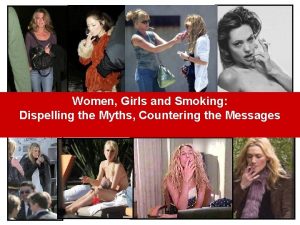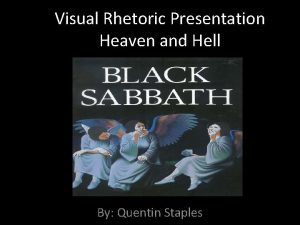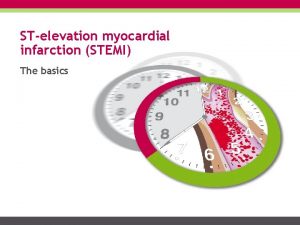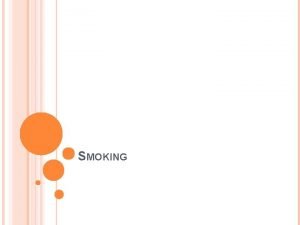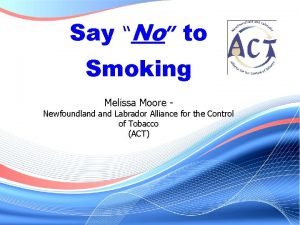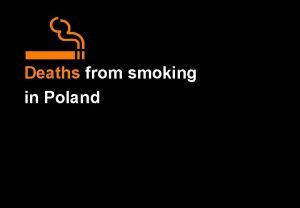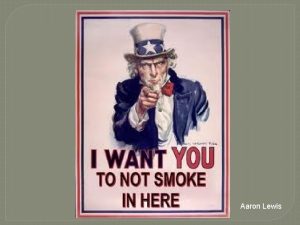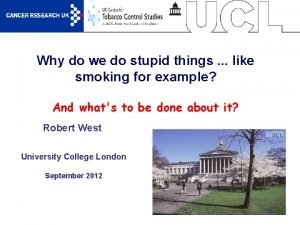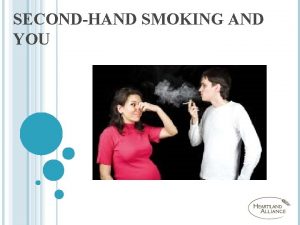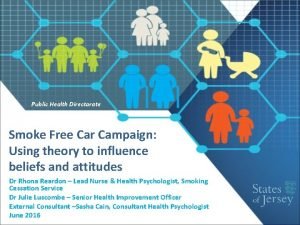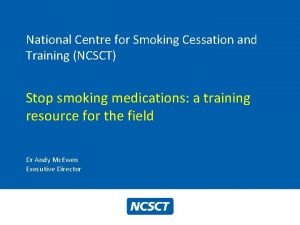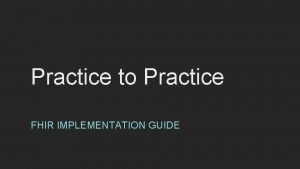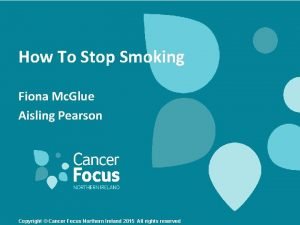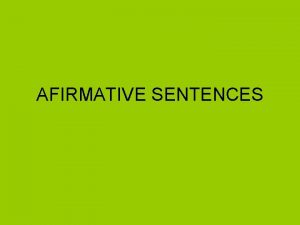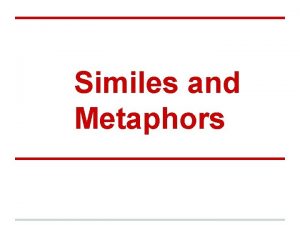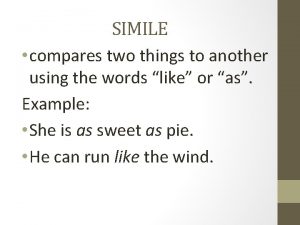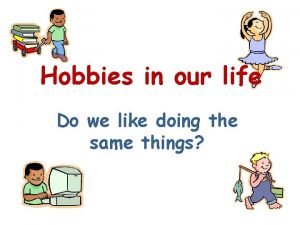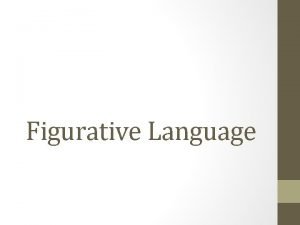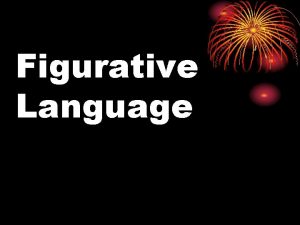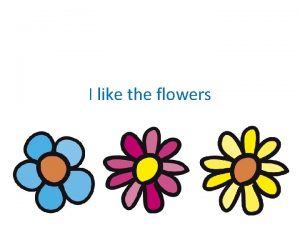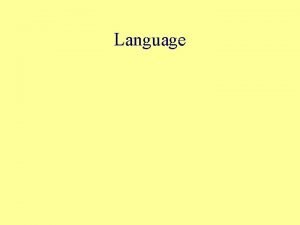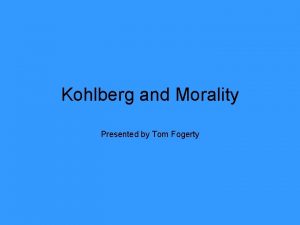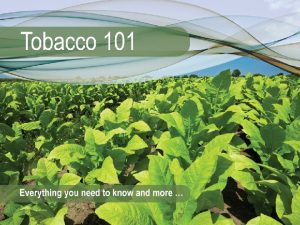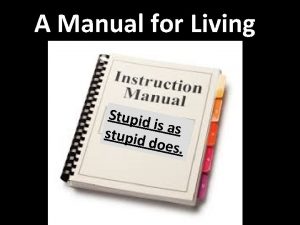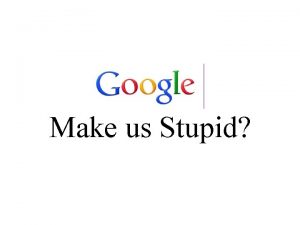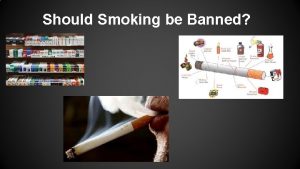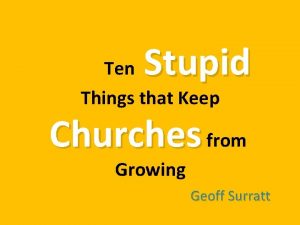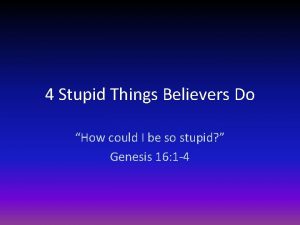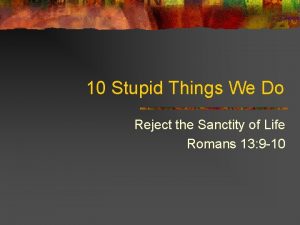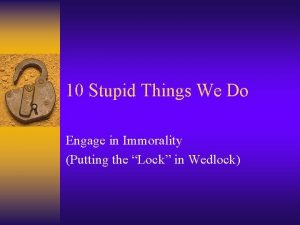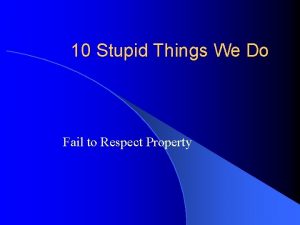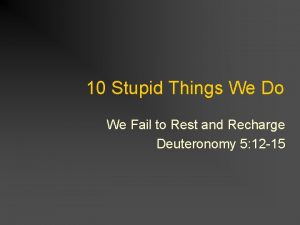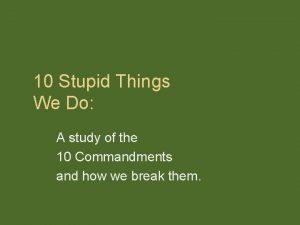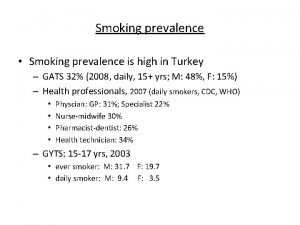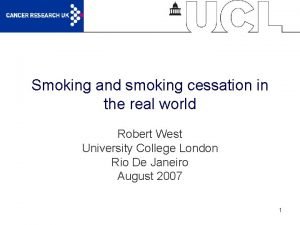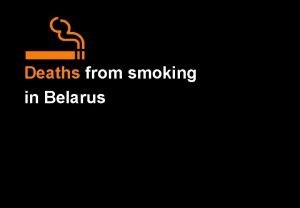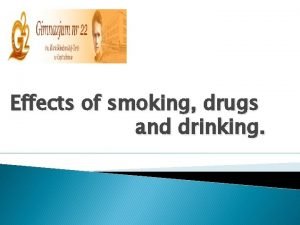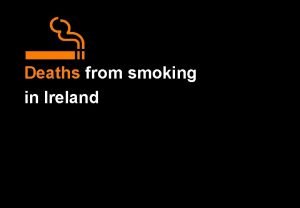Why do we do stupid things like smoking





















































































- Slides: 85

Why do we do stupid things. . . like smoking for example? And what's to be done about it? Robert West University College London September 2012 1

Aims To use observations on cigarette smoking to show a ‘synthetic model’ (COM-B+PRIME) can explain diverse features of human behaviour and guide interventions to help us act more ‘rationally’ 2

Outline 1. What is stupidity and in what way is smoking stupid? 2. Observations about cigarette smoking and models of behaviour 3. Application of the synthetic (COM-B+PRIME) model 3

Outline 1. What is stupidity and in what way is smoking stupid? 2. Observations about cigarette smoking and models of behaviour 3. Application of the synthetic (COM-B+PRIME) model 4

What is stupidity? • Acting – in a way that has a significant risk of causing harm or fails to take advantage of an opportunity – when an unbiased cost-benefit analysis taking account of the relevant information using one’s own values and preferences – leads, or would have led, to a different course of action 5

Put another way I wonder what would happen if I put my head in 6

Why is smoking mostly stupid? Most smokers. . . • lose around 6 hours of life expectancy each day that they smoke • rate their health at a level equivalent to someone 10 years older • report that they do not enjoy smoking • report higher levels of stress than non-smokers and when they stop average stress levels reduce • want to stop and try many times • and carry on smoking 7

Outline 1. What is stupidity and in what way is smoking stupid? 2. Observations about cigarette smoking and models of behaviour 3. Application of the synthetic (COM-B+PRIME) model 8

Laws, models and theories • Laws express generalisations – E=mc 2 – Thorndyke’s Law of Effect • Models represent structures and the relationships between their elements – The double helix structure of DNA – Theory of Planned Behaviour • Theories provide explanations for things – Atomic theory – Homeostatic drive theory 9

Observation and theory • With regard to explanation a theory can: – provide a simple or complex explanation – provide a coherent or incoherent explanation – fail to provide an explanation • With regard to prediction a theory can: – be agnostic – make an accurate or inaccurate prediction 10

In a given domain, a better theory. . . • Explains more relevant observations • Uses fewer concepts • Gives a wider range of, and/or more accurate, predictions • Is easier to understand use 11

In the field of behaviour change We want theories that: • explain patterns of behaviour and how these change in populations and individuals • help develop more effective intervention strategies and design more effective specific interventions than can be achieved using ‘common sense’ 12

Ten theoretical traditions 1. Decision theory (e. g. Savage, Janis) 2. Learning theory (e. g. Skinner) 3. Habit theory (e. g. Hull) 4. Drive theory (e. g. Hull) 5. Personality theory (e. g. Eysenck) 6. Identity theory (e. g. Tajfel) 7. Marketing theory (e. g. Borden) 8. Imitation theory (e. g. Heyes) 9. Social influence theory (e. g. Moscovici) 10. Dual process models (e. g. Strack and Deutsch) 13

A primer on the psychopharmacology of smoking Puff on cigarette West (2009) COPD, 6, 277 -283 Nicotine absorbed through large surface area of the lungs Rapid transport to the brain’s ventral tegmental area where nicotine attaches to acetylcholine receptors This activates neural pathway leading to dopamine release in nucleus accumbens

Decision theory • Expectancy-value models: – e. g. Choose the option with the highest ‘expected utility’ • Multi-attribute utility models – e. g. Choose option with the best utility-weighted attributes • Procedural models – e. g. Choose option according to set of IF-THEN rules 15

Knowledge and smoking • Smoking prevalence declined steeply when smokers became aware of the health risks Royal College of Physicians Report 16

Price and smoking • Many smokers and potential-smokers choose not to smoke or smoke less when it becomes more costly 17

Predictors of quit attempts • Concern about cost and belief that one could be harmed, or are being harmed are important predictors of quit attempts 1 1 West et al (2012) www. smokinginengland. info 18

Learning theory • A given response is made more or less likely when it is followed by particular types of stimulus termed positive and negative reinforcers 19

Effectiveness of medications to aid cessation • Better pharmacological blockade of nicotine’s positive reinforcing value is associated with greater efficacy in aiding smoking cessation 1 1 West et al (2008) Psychopharmacology 20

Habit theory • Repeated enactment of a given behaviour in a given context increases the likelihood that the behaviour will occur in that context without the need for a consciously formulated goal 21

Habit and smoking • Many smokers ‘automatically’ light up a cigarette in response to particular situations without thinking about why they are doing it Automatic subscale of the SMQ 1 I light up a cigarette without realising I still have one burning in the ashtray I smoke automatically without thinking about it I find myself smoking without remembering lighting up 1 West et al (1985) Psychopharmacology 22

Dependence in non-daily smokers and cue driven urges • Even non-daily smokers experience ‘urges’ to smoke in particular situations and have a low probability of success when they try to stop 1 65% failed in their most recent quit attempt within 6 months 1 Kotz et al (2012) Addiction 23

Short-term effect of smoke-free legislation • Smoke-free legislation was followed by a sharp decline in smoking prevalence until the recession hit West et al (2012) www. smokinginengland. info 24

Smoke-free and quitting • It was not due to an increase in quit attempts West et al (2012) www. smokinginengland. info 25

Smoke-free and quitting • It appears to have been due to an increase in success of quit attempts West et al (2012) www. smokinginengland. info 26

Drive theory • The brain generates subjective needs in response to ‘biologically’ driven imperatives which then generate behaviours to reduce that need 27

The time course of urges to smoke • Urges to smoke increase during abstinence then decline logarithmically, consistent with an acquired drive 1 1 Ussher et al (In press) Psychopharmacology 28

Effect of glucose on urges to smoke Desire for a cigarette • Glucose tablets reduce urges to smoke in abstaining smokers compared with low calorie sweet 1 * *p<0. 001 1 West et al (1999) Psychopharmacology for time x group interaction 29

Effect of nicotine products on urges to smoke • Nicotine products reduce urges to smoke without providing positive pleasure or satisfaction 1 1 West et al (2001) Psychopharmacology 30

Effectiveness of different medication types West et al (In Preparation) Derived 95% confidence interval from rate ratio in Cochrane reviews applied to 12 m placebo continuous abstinence rates; all medications used with some behavioural support 31

Effectiveness of different forms of NRT West et al (In Preparation) Derived 95% confidence interval from rate ratio in Cochrane reviews applied to 12 m placebo continuous abstinence rates; all medications used with some behavioural support 32

Different ways of using NRT West et al (In Preparation) Derived 95% confidence interval from rate ratio in Cochrane reviews applied to 12 m placebo continuous abstinence rates; all medications used with some behavioural support 33

Self-control theory • Self-conscious control of behaviour requires formulation of a plan or personal rule that has sufficient motivational force when relevant to overcome sources of motivation arising from habits, drives and emotion. This requires and depletes mental energy. 34

Breath-holding and success • Smokers who give in earlier when trying to hold their breath are less likely to succeed in stopping smoking 1 Abstract A pre-treatment test of breath-holding endurance predicted end-oftreatment outcome in 56 Smokers Clinic clients (r =. 44; p less than . 001). The cut off points derived by discriminant analysis were 32 seconds for men and 20 seconds for women, which correctly classified 78. 6% of cases. . . 1 Hajek et al (1987) Addictive Behaviors 35

Predictors of success • A cessation attempt made soon after a failed attempt is less likely to succeed 1 N=9, 847 1 West et al (2012) www. smokinginengland. info 36

Predictors of success • Quit attempts made abruptly rather than gradually are more likely to be successful 1 N=9, 847 1 West et al (2012) www. smokinginengland. info 37

Personality theory • Individuals differ in a number of relatively stable traits relating to their emotional reactions, thought processes and action tendencies and these differences account for a wide range of differences in behavioural responses 38

Personality factors and uptake and maintenance of smoking • Pre-disposition to sensation seeking, impulsivity and antisocial motivation are positively predictive of taking up smoking 39

Identity theory • We form thoughts, images and feelings relating to ourselves which shape our behaviour 40

Identity and smoking • Positive smoker identity is an important predictor of not trying to quit, over and above other smoking motives 41

Marketing theory: The marketing mix • Consumers will buy goods and services to the extent that, and at a time when, they feel they want or need them as long as it is easy and the price is right Product Promotion Place Price 42

Key events and cessation • Cessation attempts are triggered by significant event: New Year and No Smoking Day 1 1 Kotz et al (2012) Tobacco Control 43

Ad campaigns and cessation activity West et al (2010) All Party Parliamentary Group report 44

Imitation theory • We often imitate behaviours that we observe without necessarily realising that we are doing it 45

Imitation and smoking • Smokers tend to light up when others light up, other things being equal 1 1 Harakeh et al (2012) Drug and Alcohol Dependence 46

Social influence theory • Individuals influence each other’s behaviour reciprocally through a numbers of active and passive mechanisms, including identification, persuasion, and imitation. 47

Social influence theory and smoking cessation • Smokers tend to stop in clusters and continuing smokers find themselves in the periphery of social networks 1 1 Christiakis et al (2008) NEJM 48

Outline 1. What is stupidity and in what way is smoking stupid? 2. Observations about cigarette smoking and models of behaviour 3. Application of the synthetic (COM-B+PRIME) model 49

A synthetic model Aims to provide • a more comprehensive model of behaviour within which existing models can be understood and compared • a basis for improving existing models • a rational basis for the design of interventions to change behaviour 50

The COM-B model of behaviour Michie et al (2011) Implementation Science 51

Intelligence and stupidity Sources of stupidity: • Incapability: ignorance and bounded rationality • Motivated irrationality interacting with • Stupidogenic environment 52

Ignorance We: • are not exposed to relevant, accurate information or • fail to understand information to which we are exposed 53

Put another way www. bigthink. com ‘The veil of ignorance’ 54

Bounded rationality We: • oversimplify • overgeneralise • have limited attention span • forget things • have limited vocabulary • use the wrong rules for working things out • misapply rules for working things out 55

Put another way If some A are B, and most B are C so. . . no wait. . . if all C are some B. . . hang on. . . damn, I’ve forgotten the question 56

Motivated irrationality Much stupidity arises from: • momentary dominance of – learned (habitual) and unlearned (instinctive) stimulusimpulse associations and – learned and unlearned stimulus-affect associations • over, and influence on: – evaluations and plans arising from analysis and inference 57

Put another way I hate it when you make me look like an idiot 58

Stupidogenic environment Exposure to: • habit triggers • emotion triggers • chemical and psychological ‘insults’ • targets for imitation • targets for identification 59

Put another way 60

PRIME Theory and the structure of human motivation 61

The rider and the donkey model of behaviour 62

Reflective Impulsive Action Affective Reflective Impulsive Action PRIME Theory and Dual Process Theories 63

PRIME Theory: 1 st law of motivation • At every moment we act in pursuit of our strongest motives (wants or needs) at that moment – Want: anticipated pleasure or satisfaction – Need: anticipated relief from, or avoidance of, mental or physical discomfort 64

PRIME Theory: 2 nd law of motivation • Evaluations (beliefs about what is good and bad) and plans (self-conscious intentions to do or not do things) can only control our actions if they create motives at the appropriate moments that are stronger than competing motives coming from other sources 65

PRIME Theory: 3 rd law of motivation • Self-control (acting in accordance with plans despite opposing motives) requires mental energy and depletes reserves of that energy 66

PRIME Theory: 4 th law of motivation • Our identities (thoughts, images and feelings about ourselves) can be a powerful source of motives – Labels: the categories we think we belong to – Attributes: the features we ascribe to ourselves – Personal rules: imperatives about what we do and do not do 67

PRIME Theory: 5 th law of motivation • Motives influence actions by creating impulses and inhibitions, which are also generated by habitual (learned) and instinctive (unlearned) associations; behaviour is controlled by the strongest momentary impulses and inhibitions 68

Sources of urges to smoke Smoking triggers Reminders Positive beliefs about smoking Want or need to smoke Urge to smoke Nicotine ‘hunger’ 69

Sources of resolve not to smoke Reminders ‘Non smoking’ personal rule Want or need not to smoke Beliefs and feelings about smoking and abstinence Resolve not to smoke Ability to inhibit impulses 70

Explaining facts about smoking cessation Relapse is driven by: 1. momentary urges to smoke that are caused by ‘nicotine hunger’ and ‘cue driven urges’, that diminish over time as the key brain pathways normalise 2. positive evaluations of smoking as helping with stress 3. limited mental energy needed for the exercise of selfcontrol 4. absence of an adequate ‘plan’ that sets clear boundaries around the behaviour 5. failure to have adequate activities and mental process to prevent urges overpowering resolve 6. failing to adopt a strong ex-smoker identity 71

VBA Training for GPs • 20 min course on offering assistance to all smokers 72

Stop. Advisor • Internet site to aid cessation through established behaviour change techniques (BCTs) 73

SF 28 • Smartphone application to aid smoking cessation using established BCTs 74

Four weeks to freedom • DVD and website to trigger a ‘quality’ quit attempt 75

NCSCT standard treatment programme • Treatment plan for face-to-face support based on established BCTs 76

Overcoming stupidity 1. Provide relevant, accurate information in a form that can be understood and will be believed 2. Train rational thinking 3. Give strength to sensible plans and evaluations 4. Strengthen stimulus-impulse and stimulus-affect associations that support sensible plans and evaluations 5. Weaken stimulus-impulse and stimulus-affect associations that conflict with sensible plans and evaluations 6. Remove temptations and opportunities to think and act stupidly 7. Provide cues and opportunities to think and act sensibly 77

Put another way 78

Overcoming stupidity 1. Provide relevant, accurate information in a form that can be understood and will be believed 2. Train rational thinking 3. Give strength to sensible plans and evaluations 4. Strengthen stimulus-impulse and stimulus-affect associations that support sensible plans and evaluations 5. Weaken stimulus-impulse and stimulus-affect associations that conflict with sensible plans and evaluations 6. Remove temptations and opportunities to think and act stupidly 7. Provide cues and opportunities to think and act sensibly 79

Put another way You seem to know my mind! 80

Overcoming stupidity 1. Provide relevant, accurate information in a form that can be understood and will be believed 2. Train rational thinking 3. Give strength to sensible plans and evaluations 4. Strengthen stimulus-impulse and stimulus-affect associations that support sensible plans and evaluations 5. Weaken stimulus-impulse and stimulus-affect associations that conflict with sensible plans and evaluations 6. Remove temptations and opportunities to think and act stupidly 7. Provide cues and opportunities to think and act sensibly 81

Put another way 82

Conclusions • Stupidity stems from: – ignorance – bounded rationality – motivated irrationality – stupidogenic environment • We can help people overcome it by: – improving knowledge and understanding – giving strength to sensible plans – getting habits and emotions in line with these plans – providing a physical and social environment conducive to sensible plans 83

The Tobacco Research Group • • • Susan Michie Ann Mc. Neill Paul Aveyard Andy Mc. Ewen Jamie Brown Emma Beard Rachel Davis Leonie Brose Daniel Kotz John Stapleton Lion Shahab • • • Fabiana Lorencatto Ildiko Tombor Bidyut Sarkar Miriam Armstrong Aleksandra Herbec Tobias Raupach Emma Croghan Michael Ussher Stuart Ferguson 84

Thank you www. rjwest. co. uk www. primetheory. com 85
 Hey hey bye bye
Hey hey bye bye Why does ethanol look like water but behave more like wood?
Why does ethanol look like water but behave more like wood? Half lambert shading
Half lambert shading Google translate french to english
Google translate french to english If stupid could fly you'd be a jet
If stupid could fly you'd be a jet The stupid company
The stupid company Prueba del libro franny el tiempo todo lo cura
Prueba del libro franny el tiempo todo lo cura Midnight snackers football team
Midnight snackers football team Stupidest quotes of all time
Stupidest quotes of all time Nnn is stupid
Nnn is stupid Language
Language Is google making us stupid
Is google making us stupid Noun suffixes improve
Noun suffixes improve Bigram model
Bigram model Diversity is stupid
Diversity is stupid Key points of leadership
Key points of leadership Its the prices stupid
Its the prices stupid What color is this?
What color is this? Dont ask why why why
Dont ask why why why Difference between living and non living organisms
Difference between living and non living organisms Seven life processes pictures
Seven life processes pictures 30 pack year smoking history means
30 pack year smoking history means Curious george smoking a pipe
Curious george smoking a pipe Smoking cessation learning objectives
Smoking cessation learning objectives Smoking kills
Smoking kills Calculate smoking pack years
Calculate smoking pack years Whats passive smoking
Whats passive smoking A young chicken whose meat is tender and soft
A young chicken whose meat is tender and soft Kathleen quinlan smoking
Kathleen quinlan smoking An old man turned 98
An old man turned 98 Conclusion of balanced diet
Conclusion of balanced diet Imagery in persuasive writing
Imagery in persuasive writing Type of smoking
Type of smoking Chantix side effects
Chantix side effects Pasive smoking
Pasive smoking Lppen
Lppen Creating supportive environments smoking
Creating supportive environments smoking 5 as smoking cessation flow chart
5 as smoking cessation flow chart Sudha chandran artificial leg
Sudha chandran artificial leg Chatzy smoking
Chatzy smoking Do you mind clean
Do you mind clean Fallon sherrock smoking
Fallon sherrock smoking Logical fallacies in thank you for smoking
Logical fallacies in thank you for smoking Nadia smoking
Nadia smoking Smoking damages your lungs
Smoking damages your lungs Deaths from smoking
Deaths from smoking Quentin staples
Quentin staples Lateral leads
Lateral leads Good morning smoking
Good morning smoking Melissa moore smoking
Melissa moore smoking Smokers radiation
Smokers radiation Smoking in poland
Smoking in poland Aaron lewis smoking
Aaron lewis smoking Conclusion of smoking
Conclusion of smoking Imitation theory
Imitation theory Would you mind turning down the tv i'm working
Would you mind turning down the tv i'm working Characteristics of a good paragraph
Characteristics of a good paragraph True and false questions about smoking
True and false questions about smoking Who are second hand smokers
Who are second hand smokers Ncsct smoking cessation
Ncsct smoking cessation Smoking history taking
Smoking history taking Smoking cessation learning objectives
Smoking cessation learning objectives Fhir smoking status
Fhir smoking status Fiona stopped smoking last year
Fiona stopped smoking last year Smoking bamboo treatment
Smoking bamboo treatment Has caron talked to kevin
Has caron talked to kevin Metaphor for boring
Metaphor for boring Comparing two things without using like'' or as
Comparing two things without using like'' or as Simile definition
Simile definition Bbc 1 shedule
Bbc 1 shedule Comparison of two things using like or as
Comparison of two things using like or as Mosquito and the ear things fall apart
Mosquito and the ear things fall apart Literary devices simile
Literary devices simile Language
Language What am i animal riddles
What am i animal riddles A comparison of two dissimilar things
A comparison of two dissimilar things Prefer grammar
Prefer grammar Remo university of alberta
Remo university of alberta Which features of the sun look like huge cloud-like arches?
Which features of the sun look like huge cloud-like arches? Like minds like mine
Like minds like mine Who does he look like
Who does he look like What he looks like or how he looks like
What he looks like or how he looks like Boomwhackers i like the flowers
Boomwhackers i like the flowers Language
Language Postconventional morality
Postconventional morality Definisi pop art
Definisi pop art

